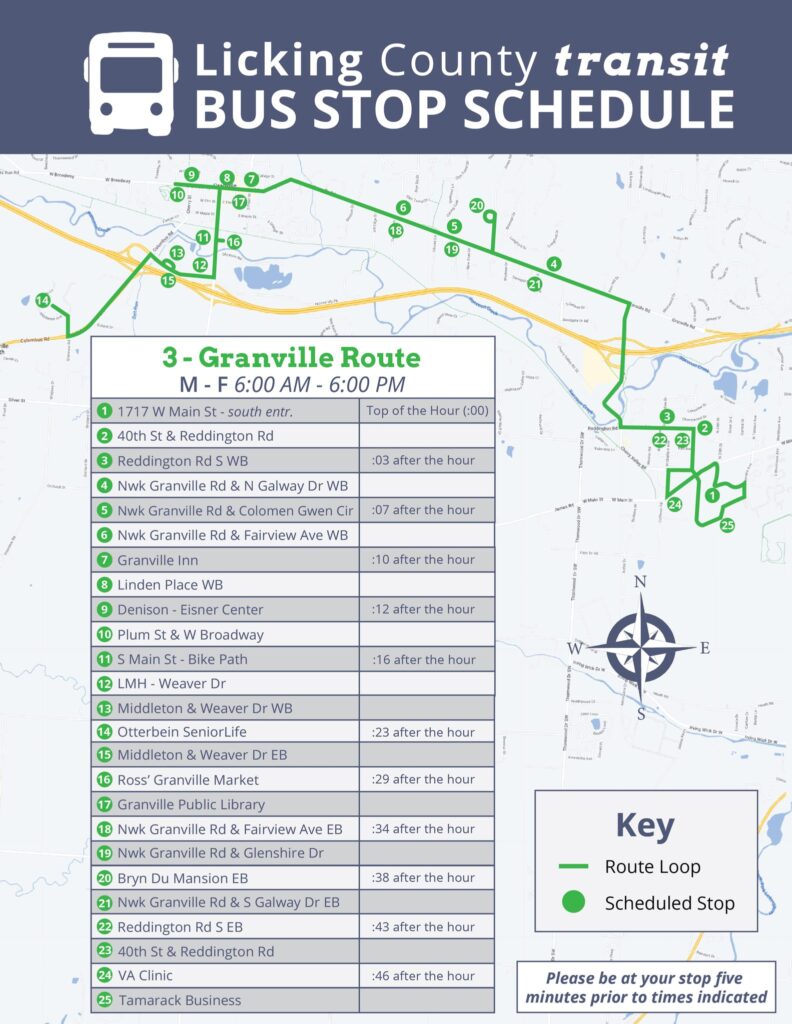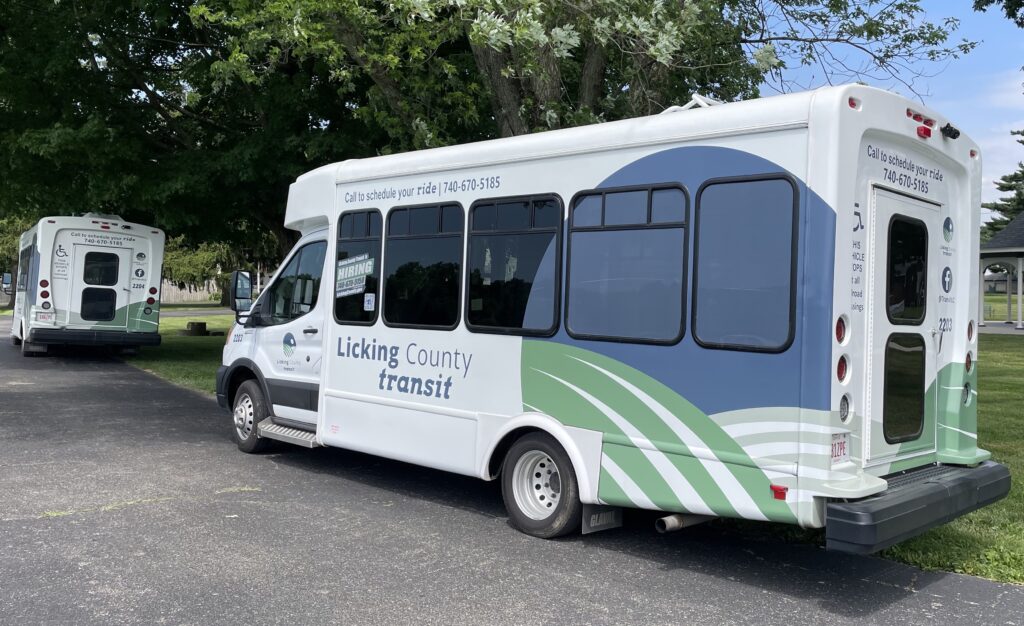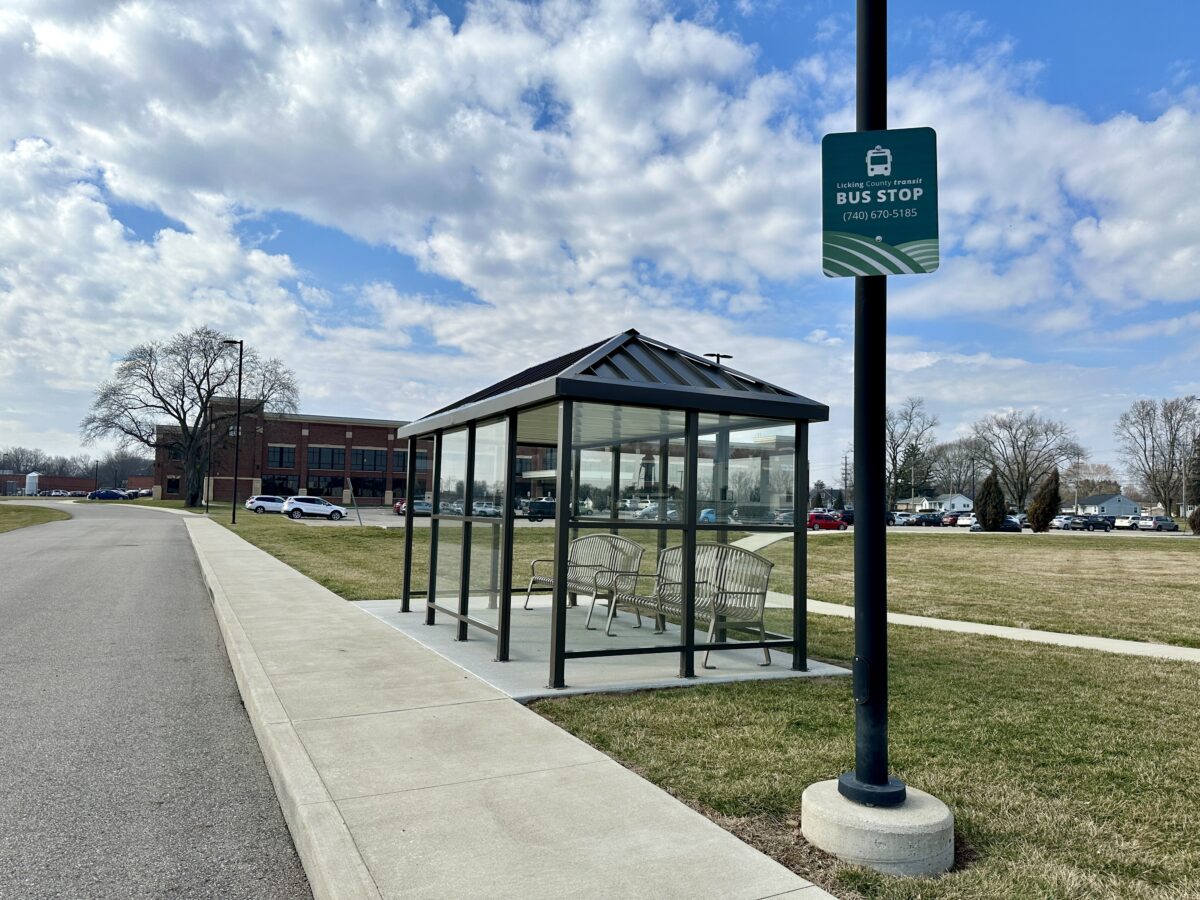A new bus route circulating in Granville and connecting with Newark will begin operating on March 4, and Licking County Transit Executive Director Matt Allison said it will bring freedom and independence to residents of both communities.
The 25-stop route, dubbed Granville’s “Green Line,” will include stops at Bryn Du Mansion, the Eisner Center at Denison University, Ross’ Granville Market and the public library in Granville, and the Veterans Administration facility in Newark, as well as areas along West Main Street in Newark, Allison said.

This is the third bus line Licking County Transit has launched in the last year as part of a pilot program, and it’s the first time that Granville has been included on a route. The first route began operating along Newark’s Main Street on July 10 last year, and service expanded with a second route along 21st Street in Newark on Oct. 23.
To meet the needs of Licking County residents, the transit service chose a hybrid transit model. Instead of operating along a fixed line, buses “can deviate from that route … up to three-quarters of a mile” if the drivers have been alerted in advance to a location where a rider wants to get on or off the bus, Allison said.
More than 5,000 people rode the first two bus lines in 2023, and already, more than 3,000 have ridden the routes in 2024.
“It’s just growing tremendously,” Allison said. “It’s always exciting for us. We see the daily numbers come out, like ‘how did we do?’”
Like the other two routes, the Green Line will operate on weekdays from 6 a.m. to 6 p.m. All three converge near the intersection of W. Main Street and Tamarack Road at 1717 W. Main St. — the home base for the bus route. There, Green Line riders will have the opportunity to transfer to the other routes, connecting them with the stops that the Green Line does not serve.
“We’re really excited about this route,” Allison said. “We’ve been working closely with community partners, stakeholders, and Granville to launch this third route.”
The Main Street route runs from near Licking Memorial Hospital on the west end to the Licking County Aging Partners center on the east end, and the 21st Street line runs from near the hospital to 21st Street and north to Price Road, including stops at Kroger, Walmart, and Ohio State University – Newark and Central Ohio Technical College.
Bus operators serve an average of between 100 and 110 riders across the current two routes.
“When we go out and ride, we hear people saying what this service means to them,” Allison said.
While celebrating “Ohio Loves Transit” week in mid-February, Allison rode the current bus lines and met with other travelers around Licking County.
One woman approached Allison and his team. She “smiled for us really big and she said, ‘This really means freedom,’” Allison said. He also has received positive feedback from senior citizens grateful for their newfound independence, and from Licking County residents without vehicles who are now able to get to work, socialize, and make doctor’s appointments with ease.
“We have story after story like that,” Allison said. “I think that’s what means the most to us – the impact to the community and how it’s changing lives.”
In 2020, the transit system worked with its partners to conduct the Licking County Area Transportation Study (LCATS). The study was intended to assess the needs and wants of the community when it comes to public transit, and it included the input of more than 900 stakeholders.
Ultimately, the study found that Licking County needed a more robust transit system to allow more flexibility for residents, especially those headed to and from OSU-Newark, Denison, and Central Ohio Technical College, Allison said. Finally, after a delay because of the COVID-19 pandemic, the transit system is implementing its plan.
Jeremy King, Denison University’s Director of Sustainability and Campus Improvement, has been involved in getting the Granville line up and running.
“We all have to remember that this is Licking County’s first foray into fixed route transit service in 50 years,” King said. “We are piloting these new lines, and as we demonstrate their success, it will allow the county to continue to grow public transit options.”
Prior to launching fixed-route services, Licking County Transit had been offering transit on demand – like a taxi service with buses – for “many years,” Allison said. By calling the transit system, riders can request a pick-up and drop-off anywhere from 24 hours to 2 months in advance. This service remains available even as fixed routes expand.

The transit system entered a partnership with the Central Ohio Transit Authority (COTA) in May 2022. In addition to directing Licking County Transit, Allison serves on the COTA leadership team. Since this partnership began, the Licking Count system has been working to rebrand, increase staffing, and improve services for the community, he said.
King said the Federal Transit Administration covers half of the operating costs, but the other half has to come from local sources.
“The biggest challenge involves finding the local matching funds … to operate a line. Each line costs about $200,000 per year,” King said.
“The community is stepping up in a tremendous way to help us,” Allison said. “We’re also truly thankful to all the community stakeholders that have helped to support us as we seek local funding.”
The Granville Green Line so far has had financial support from Denison, the Village of Granville, Granville Township, Otterbein Granville SeniorLife Community, Middleton, and the Granville Community Foundation, King said.
The two Newark Lines have been supported by Ohio State University – Newark, COTC, Licking County Health Department, and Licking Memorial Health Systems. As Intel’s development of a $20 billion computer-chip factory complex in western Licking County changes the landscape of the region, the transit system is prepared to grow with it.
“These new transit routes will continue to enhance accessibility and connectivity for the community,” Allison said. “We’re just really eager to contribute our expertise and to collaborate, to be partners to ensure a successful implementation of these routes.”
Torria Catrone writes for TheReportingProject.org, the nonprofit news organization of Denison University’s Journalism program, which is funded by the Mellon Foundation and donations from readers.

